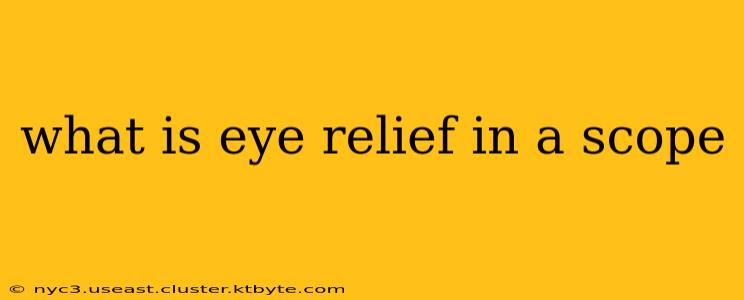Eye relief, in the context of scopes (whether riflescopes, spotting scopes, or monoculars), refers to the distance between the rear lens element of the scope and the shooter's eye when the reticle is in sharp focus. It's measured in millimeters (mm) or inches (in). Understanding eye relief is crucial for comfortable and safe shooting, particularly with high-powered scopes. Insufficient eye relief can lead to injury.
Why is Eye Relief Important?
Proper eye relief is paramount for several reasons:
-
Safety: Insufficient eye relief means your eye will be too close to the scope's lens. When the rifle recoils, the scope can hit your eye, causing serious injury. This is a particularly significant concern with high-powered rifles and magnifications.
-
Comfort: With inadequate eye relief, you'll have to constantly adjust your eye position to achieve a clear view of the reticle and target. This can lead to eye strain, headaches, and ultimately, a less enjoyable shooting experience.
-
Clear View: Optimal eye relief ensures you see the entire field of view clearly, including the reticle. Improper eye relief can result in a "tunnel vision" effect, obscuring parts of the image.
-
Consistent Shooting: Maintaining consistent eye placement is essential for accurate shooting. Sufficient eye relief allows for a consistent cheek weld, ensuring repeatable shot placement.
Understanding Eye Relief Numbers
Eye relief specifications are usually provided by the scope manufacturer. Generally:
-
Low Eye Relief (under 3 inches/76mm): Requires careful eye placement and is generally less forgiving of slight movement. Common in older or lower-priced scopes. Increased risk of recoil injury.
-
Medium Eye Relief (3-4 inches/76-102mm): Offers a good balance between field of view and safety. A widely acceptable range for most shooters.
-
High Eye Relief (over 4 inches/102mm): Provides a greater margin of error for eye placement, making it safer and more comfortable, especially for shooters with glasses or those using higher magnification. Ideal for those who wear eyeglasses.
How to Find Your Optimal Eye Relief
Determining the optimal eye relief for you is crucial. There's no one-size-fits-all answer, as it can vary based on individual facial structure, scope design, and personal preference.
-
Mount the Scope: Securely mount your scope on your firearm.
-
Assume Shooting Position: Get into your normal shooting position with your cheek weld firmly against the stock.
-
Slowly Adjust Your Eye Position: Slowly move your eye towards and away from the eyepiece until the reticle is in sharp focus. Notice the distance between your eye and the scope's eyepiece. If the image is blurry or you feel your eye is uncomfortably close to the scope, you may need a scope with higher eye relief.
-
Test for Recoil Safety: With an unloaded firearm, simulate recoil by gently moving the rifle towards your eye. Make sure there's enough distance to prevent eye contact with the eyepiece.
Eye Relief and Scope Type
The required eye relief can also vary depending on the type of scope:
-
Riflescopes: Eye relief is crucial here due to recoil. Higher magnification scopes often require higher eye relief.
-
Spotting Scopes: Recoil is not a factor, so eye relief requirements are less critical, although a comfortable viewing distance is still essential.
-
Monoculars: Similar to spotting scopes, comfort and clear viewing are the priorities.
Choosing a Scope with Appropriate Eye Relief
When selecting a scope, pay close attention to the advertised eye relief. Don't hesitate to ask questions from reputable retailers or consult online reviews to get feedback from other users. Prioritizing safety and comfort should be paramount in your scope selection process. Prioritizing a scope with appropriate eye relief ensures a safe, comfortable, and enjoyable shooting experience.

